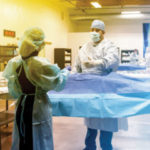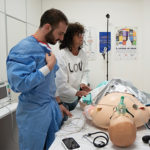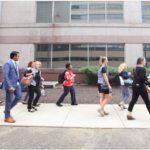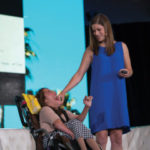Twenty-five meeting planners spent two days behind the scenes at rsna 2013 — and learned that the bells and whistles of the world’s largest international medical meeting aren’t so far out of reach.
To many meeting professionals, a visit to RSNA, the Scientific Session and Annual Meeting of the Radiological Society of North America, may seem like taking a tour of a dream home. While there are lots of enviable features, and you might marvel at the sophisticated styling, it mostly seems the stuff of fantasy, beyond reach financially and logistically.
That’s because in many ways, RSNA is the dream house of meetings. Although attendance has fallen from its pre-recession high of 62,501 in 2007, RSNA remains the world’s largest international medical meeting. RSNA 2013, held on Dec. 1-6 at Chicago’s McCormick Place, drew more than 53,000 attendees and filled 450,000 square feet of exhibit space with 662 exhibiting companies. Larger exhibitors, such as GE Healthcare, paid between $30 and $50 per square foot (depending on exhibitor status) for vast booths that were as big as 100 feet by 300 feet, and advertising on well-positioned pillars went for $25,000 a pop.
But at its core, the meeting is still just a meeting, working to serve its attendees’ needs, and striving to establish loyalty and achieve event goals. Those are challenges relevant to meetings of any size, and RSNA offers meeting professionals lessons in how to address them. That’s what a group of 25 planners learned when they were invited to a behind-the-scenes tour of RSNA 2013 as part of PCMA’s Innovation Exchange. The two-day event, sponsored by Choose Chicago, provided the planners with access to RSNA staff and key partners. Most of the planners said they arrived at RSNA expecting to be blown away by what they saw; what surprised them was that they walked away feeling inspired and empowered.
“I expected it to be so massive and so unrelated to our reality that we couldn’t imagine translating it down to our smaller levels,” said Joyce Paschall, CMP, CAE, director of education and meetings for the American College of Occupational and Environmental Medicine, whose annual meeting draws about 1,100 attendees. “But I was pleasantly surprised by how much of what I saw was translatable.”
Karen Bradley Burnett, senior director of conferences and meetings for the American Academy of Physician Assistants (AAPA), plans an annual meeting for 8,000 to 10,000 attendees, and had the same reaction. “I went there thinking that because they’re so big and their budget is so much bigger than my budget, it would be interesting to see what they do, but [that] I wasn’t going to be able to apply anything to our meeting,” she said. “What I found was that it’s all very scalable.”
In interviews with RSNA staff and meeting planners during the event and after, Convene identified three takeaway lessons that can be applied to meetings of any size and to organizations of any capacity.
TAKEAWAY #1: BRAND YOUR ORGANIZATION FIRST, YOUR ANNUAL MEETING SECOND.
Upon entering McCormick Place’s Grand Concourse, the main entry point and thoroughfare between RSNA 2013’s two exhibit halls, attendees were greeted by dramatic fabric banners and a giant mobile hanging overhead, all swathed in RSNA’s logo and branded, two-tone blues. The concourse was free of sponsorship, and RSNA branding greeted attendees at every turn. The meeting’s theme, “The Power of Partnership,” received secondary billing. The overall effect was to immerse attendees in the organization’s brand immediately upon entering the space, according to Janet Cooper, CMP, RSNA’s director of convention operations.
That emphasis is a relatively recent change for RSNA, which is four years into a show redesign. As part of that initiative, RSNA, working with partner and general services contractor Freeman, decided to make a strong organizational statement, with less emphasis on the annual meeting theme. “In the past, almost every year there was a new look and feel, so things would have to get reprinted,” said Dustin Sparks, vice president of experience design for FreemanXP and a longtime RSNA consultant. “It was very costly, and we found that every year we were reinventing what we looked and felt like. The decision was made to come up with a unified look and feel — using consistent fabric, lighting, and materials — that extended the RSNA brand throughout the meeting, with secondary emphasis on that year’s theme. From a logistical and strategic point, it made sense to create a brand that is consistent year to year and have areas where we could infuse that year’s tagline into the event.”
Sparks points to the Grand Concourse and its centerpiece mobile as an example of how RSNA achieved that. “Between the fabrics and the mobile, 80 percent to 90 percent of the Grand Concourse is the ongoing look and feel, but the center ring in the mobile gets reprinted each year, with the year and the year’s theme,” he said. “You have the template orfoundational element of the brand, and then each year’s theme builds on that in a very strategic and succinct way so as not to conflict.”
That said, it’s not the same old, same old every year. “When RSNA debuted the new design elements four years ago, the organization invested in a custom design that would be able to live several years at our meeting,” Cooper said. “Though structural elements have been reused, each year we look at the overall footprint of the meeting and reconfigure, add, or remove, if necessary. Each year we create a new annual meeting logo and theme. Items such as these serve to differentiate one meeting from another, but strong RSNA branding is always apparent.”
Ann Marie Bray, CMP, director of meetings and educational experiences for the American Academy of Physical Medicine and Rehabilitation, also hopes to flip the branding prioritization of her organization’s annual meeting. “We brand the meeting, but I found RSNA’s emphasis on branding the association interesting,” she said a few weeks after RSNA 2013, “and have already begun discussion on this tactic with our internal marketing team.”
Bradley Burnett said AAPA’s annual meeting theme was starting to drown out its organizational identity, and seeing how RSNA managed the two inspired her to make some changes to the event, which is called ImPAct. (The “PA” is a play on the abbreviation for “physician assistant.”) “We found attendees were thinking of it in terms of ImPAct and not as presented by the Academy. They had no idea who was planning it; it was just ImPAct,” Bradley Burnett said. “Starting with this year’s meeting, we’re reducing the usage of ImPAct dramatically, and next I want to get to a place where people simply say, ‘I’m going to AAPA,’ just like they say, ‘I’m going to RSNA.’”
Of course, one of the reasons that RSNA is able to create strongly branded, evergreen pieces is because the show is held at McCormick Place each year, meaning it doesn’t have to worry about packing things up and fitting them into a different space the following year. So while some planners on the behind-the-scenes tour liked the idea of establishing a strong organizational brand, several said that doing so would create logistical challenges. At the same time, the fact that a show moves every year is the very reason that an organization might want to spend more effort emphasizing itself, according to Kirsten Olean, CMP, CAE, director of meetings for the Association of American Medical Colleges. “Branding consistency ties shows together across spaces and venues,” she said. “At RSNA, no matter where you are, you know you’re at RSNA. I want to establish an identity that demonstrates to attendees ‘this is the meeting it’s always been’ — no matter where they are.”
And organizational branding can be done on a smaller scale than RSNA’s 50-foot fabric banners or giant mobile. “You may not be creating hard construction that has to ship from location to location,” Sparks said, “but you can create a solid brand guide for everything from pre- to post-communications and everything on site, so that there is familiarity of brand. It’s the branding that creates the connectivity year to year. If you apply the brand consistently and the content changes year to year, then you create a fresh experience but retain a strong brand identity.”
TAKEAWAY #2: CREATE A SACRED SPACE.
The behind-the-scenes tour concluded in the RSNA Member Services Area, which was located away from the exhibit halls and across a skybridge, in 30,000 net square feet in McCormick Place’s Lakeside Hall D. This “sacred space,” as some of the planners came to call it, was free of sponsorship or advertising of any kind, communicated only RSNA messaging — and made a lasting impression on Innovation Exchange participants. “RSNA’s Members Services Area was incredible,” Bray said, “and I took away a lot of thoughts and ideas that I have begun sharing with my team.”
The consolidated, advertising-free space was part of RSNA’s show redesign. “The year before the redesign, we had a Member Services Area, but were all over the place,” Cooper said. “We had a store on the exhibit floor, but if you wanted membership, you had to go to registration, and information about our Research and Education Foundation was in a different place. After some analysis, we made the decision it would be great if you could centralize it all in one location and members could get everything they needed in one location.”
The new space featured designated zones for the RSNA Store, Career Center, Hall of Donors, Residents Lounge (for physicians-in-training), charging station, and more. Each zone had a specific color, with lighting and signage created to match. Using wall- and column-mounted screens and piped-in audio, RSNA displayed and broadcast messages specific to individual zones; several times a day, all the lighting in the room synchronized and the screens displayed a single RSNA message — highlighting initiatives of RSNA’s Research and Education Foundation, for example, or enhancements to the association’s website.
For Darin Dvorak, director of conferences and exhibits for the Health Care Compliance Association, the sacred-space concept resonated, as he strives to create an inclusive environment at his 2,000-person annual meeting. “We want our members to have a feeling of coming home when they come to our meeting,” he said. “The idea of having a members-only area, where members can reconnect with their compliance ‘family,’ as opposed to always having another advertisement in front of you, is very appealing.”
That said, Dvorak admitted he doesn’t have the luxury of creating a sacred space on the scale of RSNA’s, and instead may focus on abeefed-up members-only area near registration. Other planners suggested there maybe opportunities to replicate the Member Services Area on a smaller scale. “I love the concept,” Paschall said. “The trick is, not everyone has the ability to have that amount or type of setup or to manage it that way, with oodles and oodles of staff. But you can still make small, dedicated areas that emphasize to members the importance of those services and your interest in meeting their needs. If you create a separate space, you’re announcing it’s important to you, and that is important to your members.”
For AAFP’s Hoskins, the purposeful messaging in RSNA’S Member Services Area was a reminder of the branding and relationship-building opportunities that can get lost in the shuffle of a show. “Whether it’s in a member area where people are taking a break or on the screens before a session starts, there are lots of opportunities to get critical messages out, we just haven’t done it,” she said. “It’s the ‘hold music’ of the show, and it’s an opportunity we haven’t taken advantage of.”
The key to keeping sacred space sacred is to be respectful of members’ wants, Cooper said. For example, RSNA’s universal messaging was brief, two- to three-sentence announcements about major initiatives; the messaging in the different zones was a bit longer — two to three slides long — and provided deeper content about specific member services. “It’s a real fine balance, figuring out what are important things for your audience to know,” Cooper said, “and how can you best present them without assaulting them.”
TAKEAWAY #3: MAKE IT PERSONAL.
Every show strives to give attendees a personalized experienced, but that’s a particularly difficult task for an event the size of RSNA. And yet, as Innovation Exchange participants observed, RSNA succeeds through a variety of high-tech and low-tech efforts. “To be relevant and successful, it is crucial to know what your audience wants to get from your meeting and how they want to get it,” Cooper said. “This knowledge will help you and your vendors plan, create, and execute a show that will satisfy the needs of your attendees in professional, educational, and commercial realms.”
For example, RSNA still prints old-school sub-specialty guides, which allow attendees to home in on programming specific to their interests, because there is a continued demand for them. This year, the organization also added sort features and functionality to its Meeting Central website, as well as enhanced mapping tools, mobile apps, and digital navigators that allowed users to search courses by subspecialty or keyword, and technical exhibitors by products and services. To make sure all that technology wasn’t lost on the intended users, a Mobile Connect zone in the Member Services Area offered mobile app demonstrations by RSNA staff and advice on how to make the most of the show’s mobile features.
In its physical spaces, RSNA added more seating areas for in-person connection, as well as a Residents Lounge, complete with free pizza. “We try to serve up numerous ways for attendees to connect with content and people,” Cooper said. “So we designed small, intimate spaces for people who want to connect one to one, as well as opportunities for people who enjoy larger gatherings.”
Paschall admired the Residents Lounge area and hopes to replicate it on a smaller scale. “I’ve wanted to do a residents and fellows lounge for a while, because I think it would be beneficial to bring those two groups together” she said. “Theirs was huge and had food-and-beverage. I might not be able to do that, but I can drape off a space where those two segments can find each other. Seeing it done on a big scale with all the bells and whistles made me realize, ‘I can do that.’”
Growing international attendance is also a common goal among meeting professionals, and with international participants representing 38 percent of total attendees at RSNA 2013, the organization took a number of steps to ensure they had a positive experience — from making signage more language-neutral and international-friendly to hosting “Navigating RSNA 2013 Schedule” sessions in seven different languages in the Global Connection Zone within the Member Services Area.
Also in the Member Services Area, an interactive Google Maps station allowed attendees to see who was at RSNA 2013 from their home country, and to add their own contact information to a directory for meeting requests. They could also view the geographic makeup of attendees via a large world map dotted with magnetic pushpins. Though simpler in execution than the Google Maps station, the map garnered significant interest from both attendees and the planners on the tour. “I definitely want to do the world map of who’s coming from where,” Paschall said. “We have international attendees, and though it’s not a large percentage, it’s fascinating for them to find out where others are coming from. Anybody could pull that off. It could be as simple as a $5 map from Staples and thumbtacks. You could do it for $10.”
That type of customization could be applied to many of the big-show features that RSNA employs, Sparks said. In fact, adapting lessons learned to a meeting’s unique personality and parameters is the only way to adopt them successfully. “I hope no one walked away from RSNA saying, ‘I need to do this or exactly that,’ because an organization that wants to implement change must custom-fit solutions for their particular audience and goals,” Sparks said. “It’s not about copying the latest or greatest trend, but looking at innovative ways to deliver content and interact with your attendees, and then studying the specific needs and learning styles of your attendees so you can apply those strategies to your audience.”



